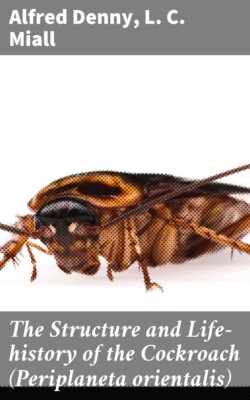Читать книгу The Structure and Life-history of the Cockroach (Periplaneta orientalis) - L. C. Miall - Страница 27
The Chitinous Cuticle.
ОглавлениеFig. 8.—Diagram of Insect integument, in section. bm, basement membrane; hyp, hypodermis, or chitinogenous layer; ct, ct′, chitinous cuticle; s, a seta.
The chitinous exoskeleton is rather an exudation than a true tissue. It is not made up of cells, but of many superposed laminæ, secreted by an underlying epithelium, or “chitinogenous layer.” This consists of a single layer of flattened cells, resting upon a basement membrane. A cross-section of the chitinous layer, or “cuticle,” examined with a high power shows extremely close and fine lines perpendicular to the laminæ. The cells commonly form a mosaic pattern, as if altered in shape by mutual pressure. The free surface of the integument of the Cockroach is divided into polygonal, raised spaces. Here and there an unusually long, flask-shaped, epithelial cell projects through the cuticle, and forms for itself an elongate chitinous sheath, commonly articulated at the base; such hollow sheaths form the hairs or setæ of Insects—structures quite different histologically from the hairs of Vertebrates.
The polygonal areas of the cuticle correspond each to a chitinogenous cell. Larger areas, around which the surrounding ones are radiately grouped, are discerned at intervals, and these carry hairs, or give attachment to muscular fibres.
Viallanes (loc. cit.) has added some interesting details to what was previously known of Insect-hairs. There are, he points out, two kinds of hairs, distinguished by their size and structure. The smaller spring from the boundary between contiguous polygonal areas, and have no sensory character. The larger ones occupy unusually large areas, surmount chitinogenous cells of corresponding size, and receive a special nervous supply. The nerve34 expands at the base of the hair into a spindle-shaped, nucleated mass (bipolar ganglion-cell), from which issues a filament which traverses the axis of the hair, piercing the chitinogenous cell, whose protoplasm surrounds it with a sheath which is continued to the tip of the hair. Such sensory hairs are abundant in parts which are endowed with special sensibility.
Fig. 9.—Nerve-ending in skin of Stratiomys larva. h, hairs; b, their chitinous base; c, nucleus of generating cell; g, ganglion cell. × 250. Copied from Viallanes.
Fig. 10.—Diagram of sensory hair of Insect. Cc, chitinous cuticle; h, hair; c, its generating cell; g, ganglion cell; bm, basement-membrane.
The chitinous cuticle is often folded in so as to form a deep pit, which, looked at from the inside of the body, resembles a lever, or a hook. Such inward-directed processes serve chiefly for the attachment of muscles, and are termed apodemes (apodemata). A simple example is afforded by the two glove-tips which lie in the middle line of the under-surface of the thorax (p. 58, and fig. 27). In other cases the pit is closed from the first, and the apodeme is formed in the midst of a group of chitinogenous cells distant from the superficial layer, though continuous therewith. Many tendons of insertion are formed in this way. The two forked processes in the floor of the thorax (p. 58, and fig. 27) are unusually large and complex structures of the same kind. In the tentorium of the head (p. 39, and fig. 17) a pair of apodemes are supposed to unite and form an extensive platform which supports the brain and gullet.
Fig. 11.—Nymph (in last larval stage) escaping from old skin. × 2 1/2.
Like other Arthropoda, Insects shed their chitinous cuticle from time to time. A new cuticle, at first soft and colourless, is previously secreted, and from it the old one gradually becomes detached. The setæ probably serve the same purpose as the “casting-hairs” described by Braun in the crayfish, and by Cartier in certain reptiles,35 that is, they mechanically loosen the old skin by pushing beneath it. In many soft-bodied nymphs the new skin can be gathered up into a multitude of fine wrinkles, which facilitate separation, but we have not found such wrinkles in the Cockroach, except in the wings. The integument about to be shed splits along the back of the Cockroach, from the head to the end of the thorax,36 and the animal draws its limbs out of their discarded sheaths with much effort. It is remarkable that the long, tapering, and many-jointed antennæ are drawn out from an entire sheath. At the same time the chitinous lining of the tracheal tubes is cast, while that of the alimentary canal is broken up and passed through the body.
Fig. 12.—Cast skin of older nymph (“pupa”). × 2 1/2.
Prolonged boiling in caustic potash, though it dissolves the viscera, does not disintegrate the exoskeleton. This shows that the segments of the integument are not separate chitinous rings, but thickenings of a continuous chitinous investment. Nevertheless, their constancy in position and their conformity in structure often enable us to trace homologies between different segments and different species as certainly as between corresponding elements of the osseous vertebrate skeleton.
